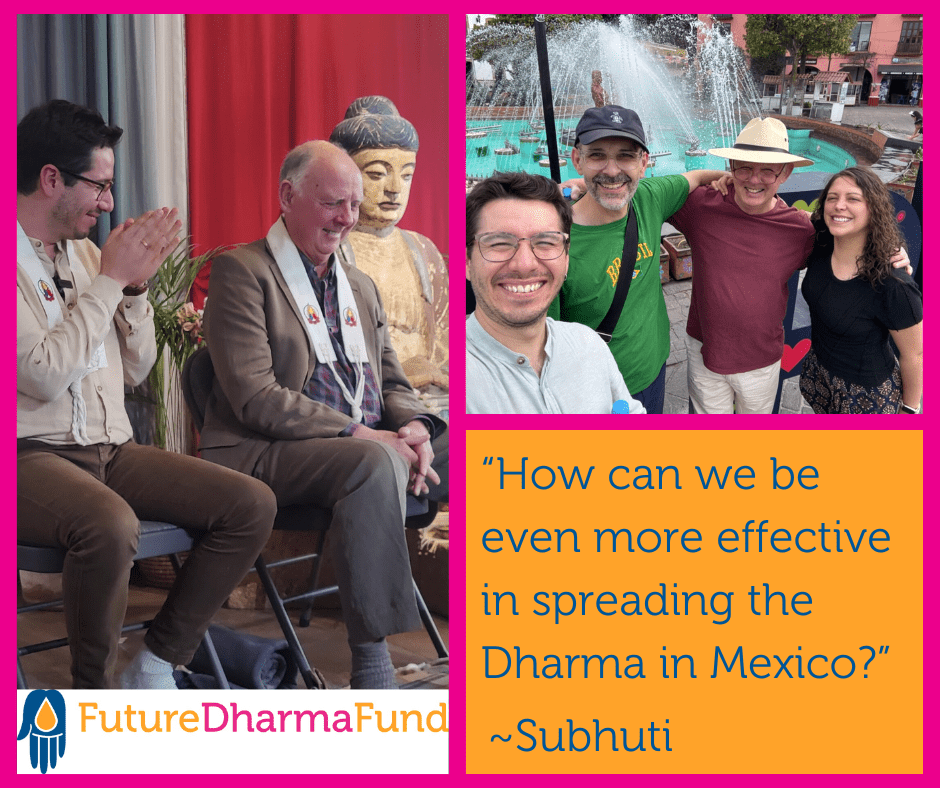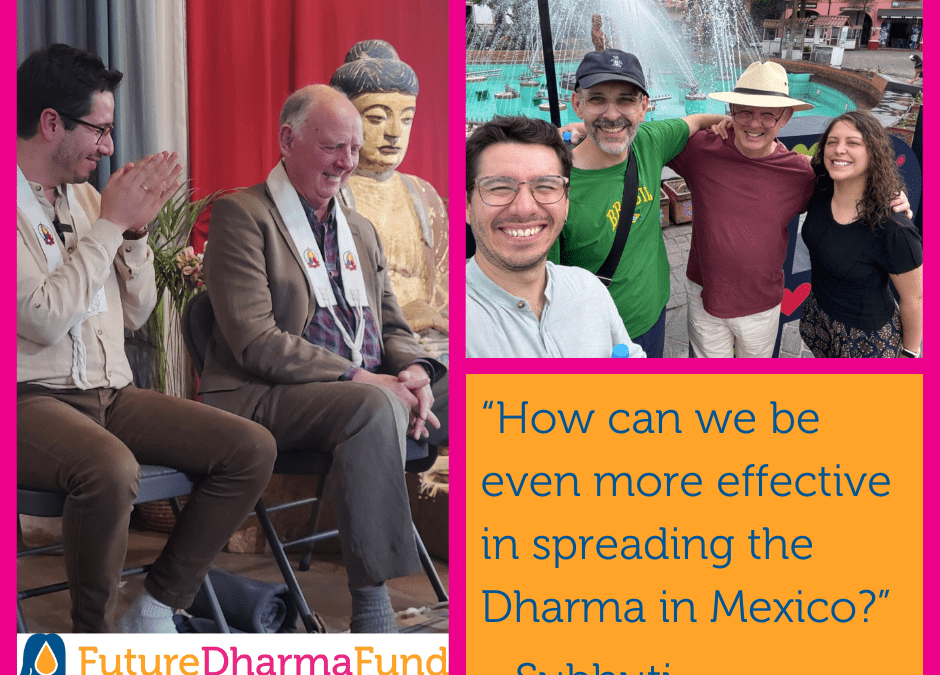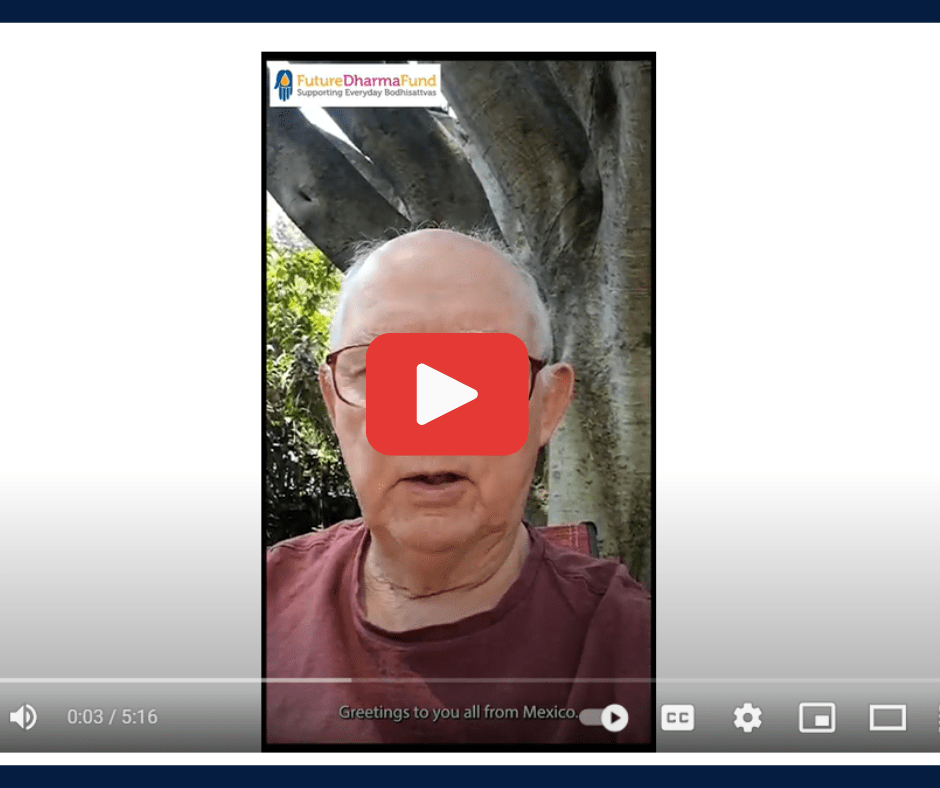
Subhuti’s reflective journey through Mexico’s spiritual landscape highlights not only the country’s cultural richness but also an emerging hub for spreading the Dharma. Enabled by the generosity of FutureDharma donors, Subhuti was able to support the development of the Order in Mexico by helping Mexican Order Members and GFR Mitras go deeper in their understanding of the Order and its principles. In the blog below, written by Subhuti, he shares with us insights from his trip, including ancient Zapotec ruins and the vibrant Dia de Los Muertos rituals, his visions for the future of Buddhism, and celebrates the transformative impact of donor support in nurturing the growth of Triratna’s community in Latin America.
“We sat in a row at one end of a stone platform: Jnanadakini, Vidyachandra, Nagapriya, and myself. Opposite us, across the open square, was an impressively monumental sixteenth century church, built with materials looted from the ruins of the religious centre that the building symbolically suppressed. To one side, we could see those ruins, richly decorated with geometric patterns in stone, each unrepeated, creating a powerful sense of energy in movement. This was the main temple, spiritual heart of the Pre-Hispanic Zapotec culture that flourished in the Central Oaxaca Valley until the Spanish conquest, and was known as the yohopàe, “The House of the Vital Spirit”. The platform on which we sat was said to be the abode of the Lord and Lady of the Underworld or mictlán in Nahuatl (hence the name of the modern village of Mitla near which the ruins lie).
We sat in silence for a while, awed by the overwhelming significance of the site, then Jnanadakini, a Mexican Public Preceptor who is herself of Zapotec decent, led us in a reflection on the deep forces present in this sacred place, requesting its ancient gods to aid us in bringing the Dharma to this beautiful land.
We had already visited a Dominican convent in the heart of Oaxaca City and gained some inspiration from those dedicated Friars, who lived an exceptionally austere life, and were well studied and trained to preach the gospel. With their Franciscan brothers, they proselytised the whole of Mexico, swiftly supplanting its old religions within just decades of the Conquest. Though there is a darker side to what they wrought, nonetheless we could not but be challenged by their courage and vigour in service to their mission. What could we not do for the Dharma, which is far purer and more beneficent, if we had half their determination and faith? We couldn’t help look out for suitable sites for a Oaxaca Buddhist Centre and dreamed that our Order could summon up even greater vigour to transform Mexico.
For me, this has been a major theme of my visit: how can we be even more effective in spreading the Dharma here? Mexico seems unusually ripe for Triratna’s approach. It has had a stable democracy for many years (the next President will almost certainly be a woman of Jewish parentage), has a very open culture, where Christianity is very much on the defensive, and enjoys a significant degree of economic development. For these reasons, it is probably the best jumping off point for the rest of Latin America, albeit each of those countries has its own distinctive culture. There is no doubt that Latin America in general, and Mexico in particular, offer great opportunities for Triratna’s growth and I greatly support FutureDharma’s decision to give it a strategic emphasis.
The movement here is at a very important stage. Upekshamati arrived 30 years ago, two years a Dharmachari and just 30 years old. There are now some 70 active Order members, and there are four well-established centres, as well as groups elsewhere. I can personally attest to the remarkable warmth and enthusiasm of those running and attending the activities – as well as to the excellence of the food provided, food being essential to any Mexican event! As in India, people seem to have no difficulty in revering, perhaps the first requirement for a genuine spiritual life. It is this atmosphere of goodwill and receptivity that is the most important reason for us to invest further in Mexico, and no doubt other Latin American countries.
Having come to this stage of development, the time has come to build further the institutions that are necessary for an effective Sangha and to organise for more dynamic spreading of the Dharma throughout this huge country and beyond. We now have four Public Preceptors in Mexico who are shouldering their responsibilities more and more – and this is an area where I have been able to offer my own support as a founding member of the Preceptors’ College, thanks to FutureDharma’s having paid my travel expenses.
Let me conclude by describing an event I attended that exemplifies the riches of Mexican culture and the creative vitality of our Sangha here. The roots of this lie in a meeting I had during my last visit to Mexico with a group of Order members and mitras, many of them involved with the arts. We discussed putting on an event during the period of the Day of the Dead, so significant and a much loved aspect of Mexican life. The idea was to have a kind of ritual presentation that would take those attending through the stages of death, the “in-between state”, and rebirth. Over the next months they came together regularly to create what turned out to be a very powerful and impressive event, which could be described as the Bardo Thödol meets the Dia de Los Muertos meets the ancient Mexican gods, presented by a team consisting of skilled musicians, professional actors, an anthropologist, and others, all Order members and mitras.
As we approached the entrance to the main shrine hall of the Mexico City Buddhist Centre, we were greeted by black-clothed figures who purified us with incense and drums. All the while, a numinous music of drum and viola filled the space, all accompanied by a steadily beating heart. The words of the great Nahuatl poet, Nezahualcoyotl, a 15th Century King and philosopher, whispered of the ephemeral nature of life. We lay down and were led through the dissolution of the elements till the heart beat ceased and we encountered the pure white light of reality. Then the five Buddhas appeared one by one, masked and robed in Pre-Hispanic style. A shadow show of the various realms of Rebirth led us to our own rebirth in fetal posture.
I am hoping this will become an annual event in Mexico and will grow in richness of imagery and power, rooting the Dharma more deeply in the mythic soil of this remarkable land.”
Subhuti


